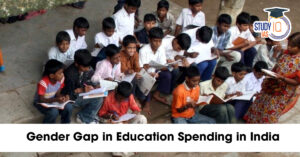Table of Contents
Context: Strategic investments in early childhood education and engaging parents will help young learners.
| Quote |
| “Some kids win the lottery at birth; far too many don’t — and most people struggle to catch up,”
– Nobel Laureate Prof. James Heckman. |
Significance of Early Childhood Education (ECE)
- Highest Return on Investment: The Heckman Curve shows that investing in ECE yields returns between $7 to $12 per $1 spent, making it the most cost-effective stage for human capital investment.
- Foundation for Future Learning & Earnings: Children with quality ECE are 4 times more likely to have higher earnings and 3 times more likely to own a home later in life.
- Reduces Inequality: ECE can mitigate the disadvantages stemming from the “lottery of birth”, i.e., being born into poverty.
- Early Skill Development: Critical cognitive and behavioral skills are formed by age 5; gaps in motivation, language, and numeracy become evident by then.
- Better School Readiness: Prepares children for formal education, reducing future learning gaps and dropout rates.
Current Challenges in India’s Early Childhood Education (ECE) System
- Insufficient Instructional Time: Anganwadi workers spend only 38 minutes/day on preschool instruction vs. the recommended 2 hours.
- Only 9% of pre-primary schools have dedicated ECE teachers.
- Weak Learning Outcomes: Only 15% of children can match basic objects, and 30% can compare numbers — essential pre-Class 1 skills.
- Low Enrollment in ECE: Many children skip pre-primary education.
- Only 2% of 3-year-olds,
- 1% of 4-year-olds,
- Nearly 25% of 5-year-olds directly enroll in Class 1.
- Inadequate Resources & Oversight: Only ₹1,263 per child/year is spent on ECE vs. ₹37,000 on school education.
- 1 supervisor per 282 Anganwadis, making quality control difficult.
- Limited Parental Engagement: Many parents care, but lack guidance on how to support ECE at home.
- Underuse of smartphones or EdTech platforms for parent training.
Government and State Initiatives
| State/Entity | Initiative | Description |
| Uttar Pradesh | Hiring 11,000 ECE educators | Across districts; plus 6-day residential training for Master Trainers. |
| Odisha | Shishu Vatikas & Jaduipedi Kits | To enhance school readiness for ages 5–6 through play-based learning. |
| Madhya Pradesh | Bal Choupal | Monthly parent engagement sessions focused on play-based learning. |
| Union Government | ICDS (Integrated Child Development Scheme) | Core national scheme for nutrition, health, and preschool education via Anganwadis. |
| NEP 2020 | Emphasis on Foundational Literacy & Numeracy | Targets universal ECE access for ages 3–6; introduces Balavatika at preparatory stage. |
What Can Be Done
- Hiring Dedicated ECE Teachers: Ensure every Anganwadi and pre-primary school has trained educators focused solely on ECE.
- Increase Funding & Monitoring: Allocate more funds to ECE (including for learning materials, infrastructure, and supervisors).
- Hire more supervisors for quality assurance.
- Strengthen Parental Involvement: Conduct community-based programs (like Bal Choupal in MP).
- Leverage EdTech and WhatsApp to guide parents in home-based learning.
- Improve Instruction Time & Pedagogy: Standardize 2 hours of play-based, age-appropriate learning
- Train educators in early childhood pedagogy.
- Promote Awareness & Enrolment: Run awareness drives to increase ECE enrolment, especially for ages 3–5.
- Integrate Shishu Vatikas and Balavatikas in schools and Anganwadis.


 Geo-tagging of Buildings During Upcoming...
Geo-tagging of Buildings During Upcoming...
 Gender Gap in Educational Expenditure in...
Gender Gap in Educational Expenditure in...
 Reservation and 50% Cap: Constitutional ...
Reservation and 50% Cap: Constitutional ...




















